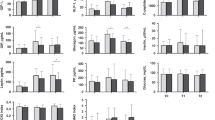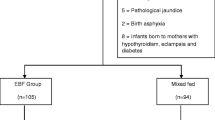Abstract
Objective
To evaluate the influence of early infancy feeding practices on fasting insulin levels, as marker of insulin resistance, in low birthweight neonates.
Methods
Eighty successive low birth weight (<2.5 kg) neonates <10 days of age born at >38 wk of gestation at this tertiary care centre, were successively invited for participation in the study; parents of 52 (65%) consented to participate. Group 1 children (n=26) were randomized to receive only breast feeding and Group 2 (n=26) received fortified breast feeding with a commercially available human milk fortifier. Routine anthropometry and evaluation of health status was performed. The babies were followed-up every 15 day up to three months. 4-hour fasting glucose and insulin levels were measured at baseline and at 3 month. Statistical analyses were performed using t-test and Mann-Whitney test.
Results
In excusively breast-fed Group 1 neonates vs Group 2 the mean birthweight was similar (1.99±0.23 vs 1.87±0.30 kg). There was no difference in body length, head circumference and chest circumference. Mean hemoglobin levels, fasting glucose (63.9±9.8 vs 64.3±8.0 mg/dl) and fasting insulin levels (1.44±1.19 vs 1.73±1.38 μU/ml), were also similar. At three month follow-up in Group 1 children receiving exclusive breast feeding, there was significantly lower weight as compared to Group 2 (3.40±0.3 vs 4.75±0.5 kg, p<0.01). This was associated with significantly lower fasting glucose (79.0±9.4 vs 85.6±8.4 mg/dl) and fasting insulin levels (6.95±4.27 vs 15.73±3.29 μU/ml) (p<0.001). The difference persisted even after adjustment for weight gain in Group 2 (weight adjusted insulin 11.26±3.3 μU/ml; p<0.001).
Conclusions
Low birthweight neonates fed fortified breast milk had greater fasting insulin levels compared to those with exclusive breast feeding, at three month of age. The difference persisted after adjustment for excessive gain in fortified milk fed neonates and, suggests adverse glucometabolic programming.
Similar content being viewed by others
References
Barker DJP. Mothers, babies and health in later life. 2nd ed. Edinburgh; Churchill Livingstone, 1998; 1–150.
McKeigue PM. Fetal effects on insulin resistance and glucose tolerance. In Reaven GM, Laws A, eds. Contemporary Endocrinology: Insulin resistance and metabolic syndrome, Vol 12, Totowa; NJ Humana Pres, 1999; 35–49.
Foren T, Eriksson J, Toumelito J, Reunanen A, Osmond C, Barker D. The fetal and childhood growth of persons who develop type 2 diabetes. Ann Intern Med 2000; 133:176–182.
Harder T, Rodekamp E, Schellong K, Dudenhausen JW, Plagemann A. Birthweight and subsequent risk of type 2 diabetes: a meta-analysis. Am J Epidemiol 2007; 165: 849–857.
Yajnik CS, Fall CH, Vaidya U et al. Fetal growth and glucose and insulin metabolism in four year old Indian children. Diabet Med 1995; 12:330–336.
Bavdekar A, Yajnik CS, Fall CH et al. Insulin resistance syndrome in 8-year old Indian children: small at birth, big at 8 years or both? Diabetes 1999; 48:222–2429.
Gupta M, Gupta R, Bhatia R, Pareek A, Kaul V. Low birth weight and insulin resistance in mid and late childhood. Ind Pediatrics 2007; 44:177–184.
Bhargava SK, Sachdev HPS, Fall CHD et al. Relation of serial changes in body mass index to impaired glucose tolerance in young adulthood. N Engl J Med 2004; 350: 865–875.
Singhal A, Fewtrell M, Cole TJ, Lucas A. Low nutrient intake and early growth for later insulin resistance in adolescents born preterm. Lancet 2003; 361:1089–1097.
Singhal A, Cole TJ, Fewtrell M, Deanfield J, Lucas A. Is slower early growth beneficial for long-term cardiovascular health? Circulation 2004; 109:1108–1113.
Eriksson JG, Forsen T, Tuomilehto J, Osmond C, Barker DJP. Early growth and coronary heart disease in later life: longitudinal study. BMJ 2001; 322: 949–953.
Singhal A, Cole TJ, Lucas A. Early nutrition in preterm infants and later blood pressure: two cohorts after randomized trials. Lancet 2001; 357: 413–419.
Lucas A, Fewtrell MS, Morley R et al. Randomized trial of nutrient-enriched formula versus standard formula for post-discharge preterm infants. Pediatrics 2001; 108: 703–711.
Fewtrell MS, Morley R, Abbott RA et al. Double-blind, randomized trial of long-chain polyunsaturated fatty acid supplementation in formula fed to preterm infants. Pediatrics 2002; 110: 73–82.
Yadav KK, Gupta R, Gupta A, Gupta M. Insulin levels in low birth-weight neonates. Indian J Med Res 2003; 118:197–203.
Kramer MS, Kakuma R. Optimal duration of exclusive breastfeeding. Cochrane Database Syst Rev 2002; Issue 1: CD003517.
West J, Wright J, Tuffnell DJ, Farrar D, Watt I. Social and lifestyle interventions for preventing low birthweight in South Asians. Cochane Database Syst Rev 2007; Issue 2: CD006500.
Gidding SS, Dennison BA, Birch LL et al. Dietary Recommendations for children and adolescents: a guide for practitioners. Circulation 2005; 112: 2061–2075.
Whincup PH, Kaye SJ, Owen CG et al. Birth weight and risk of type 2 diabetes: a systematic review. JAMA 2008; 300:2886–2897.
Martin RM, Davey Smith G, Mangtani P, Tilling K, Frankel S, Gunnell D. Breastfeeding and cardiovascular mortality: the Boyd Orr cohort and a systematic review with meta-analysis. Eur Heart J 2004; 25: 778–786.
Arenz S, Ruckerl R, Koletzko B, von Kries R. Breast-feeding and childhood obesity-a systematic review. Int J Obes Relat Metab Disord 2004; 28: 1247–1256.
Stettler N, Zemel BS, Kumanyika S, Stallings VA. Infant weight gain and childhood overweight status in a multicenter cohort study. Pediatrics 2002; 109: 194–199.
Stettler N, Stallings VA, Kumanyika S. Weight gain in the first week of life and overweight in adulthood: a cohort study of European American subjects fed infant formula. Circulation 2005; 112:e110.
Dewey KG. Nutrition, growth, and complementary feeding of the breastfed infant. Pediatr Clin North Am 2001; 48: 87–104.
Owen CG, Whincup PH, Gilg JA, Cook DG. Effect of breast feeding in infancy on blood pressure in later life: systematic review and meta-analysis. BMJ 2003; 327:1189–1195.
Owen CG, Whincup PH, Odoki K, Gilg JA, Cook DG. Infant feeding and blood cholesterol: a study in adolescents and a systematic review. Pediatrics 2002; 110: 597–608.
Author information
Authors and Affiliations
Corresponding author
Rights and permissions
About this article
Cite this article
Gupta, M., Zaheer, Jora, R. et al. Breast feeding and insulin levels in low birth weight neonates: A randomized study. Indian J Pediatr 77, 509–513 (2010). https://doi.org/10.1007/s12098-010-0065-6
Received:
Accepted:
Published:
Issue Date:
DOI: https://doi.org/10.1007/s12098-010-0065-6




